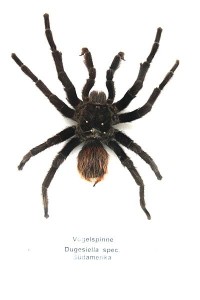
"In the large glass case in the rear of the saloon he has caged more concentrated venom than can be found anywhere outside of a poison factory."
That larger-than-life Old West character, Roy Bean, a so-called hanging judge who hardly ever hung anyone, owned a Texas saloon with an usual display case. From a report in the September 27, 1885 Brooklyn Daily Eagle, which was originally published in the Philadelphia Times:
“This is an eating station on the Southern Pacific railroad, and stands well out on the great Prison plain, about midway between El Paso and Del Rio. Old Roy Bean, who formerly dispensed frontier justice of a decidedly original and peculiar kind while acting as a magistrate at Murderville during the building of the railroad, owns the eating privilege at Sanderson and the liquid refreshing business connected therein.

"I suggested to old Roy that it would be a good idea to pull out their teeth, and he kindly gave me permission to operate on them dentally."
In the large glass case in the rear of the saloon he has caged more concentrated venom than can be found anywhere outside of a poison factory. First on the list is a family of centipedes, consisting of a giant nearly ten inches in length, the old fellow’s son and daughter and a numerous progeny of babies. The centipede is not a pretty insect. Once I thought of them as no use, but after seeing a lot of little Chiricahua Indian papooses pulling centipedes from their holes and greedily devouring them, legs, poison and all, I no longer doubted the wisdom and beneficence of their creation. In the course of my checkered career I have had several adventures with centipedes, and always came out second best. A centipede can raise a blister on a man’s body quicker than a red hot iron. If you don’t immediately apply a remedial poultice of pounded prickly pear and dose yourself inwardly with post whisky–the latter is warranted to kill anything but an army mule–the resultant effects may be serious. Centipedes usually attack their victim at night when he is asleep and can’t defend himself. They are armed with about two hundred little lances conveniently lashed to the toe of each foot–of which they have several–and at the base of each lance is a tiny sack of venom. If a centipede crawls across your body, which he’ll most likely do if you lie down anywhere within half a mile of him–you’ll have no difficulty in following his trail, and you’ll remember his visit for weeks. No man ever died from the bite of a centipede, but I have known one to make a man wish he were dead.
In the cage adjoining that occupied by the centipedes was a den of tarantulas, whose scientific name is lycosa. The den contained two lycosas, but whether they were brother and sister, mother and daughter, father and son, or husband and wife, I am unable to declare. They were about the size of a common saucer, and were as hairy as Esau. Their mouths were blood red, and they each had four red teeth, which from time to time they snapped viciously. I was bitten by a tarantula once, and I felt thankful that these two were caged. I suggested to old Roy that it would be a good idea to pull out their teeth, and he kindly gave me permission to operate on them dentally. I declined. The tarantula is an exaggerated spider, with teeth and hair. They are always ready for a fight, and will tackle anything, not excluding a buzz saw. In days gone by I have often amused myself by teasing one with a red hot coal, and never surrender until they were burned to a crisp. I never heard of anything eating a tarantula. If one bites you, use the same remedies as prescribed for centipede sting, only more so.”

